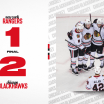Kyle Davidson doesn't take any pleasure in watching from afar as 16 other NHL teams start the grueling two-month fight for the greatest trophy in sports. But he's watching anyway. The playoffs, the Blackhawks general manager says, are a nightly education in success.
The pace, the energy and the skill level of the opening games are undeniable. It's exciting. It's also, frankly, a night-and-day difference of where his Blackhawks stand today.
"Absolutely," Davidson agreed of the visible gap on Tuesday. "You see the level that you need to get to and it's very stark, the contrast, to the teams that are in it to win it and the teams that are just a little bit behind, and the teams that are a lot behind."
FEATURE: Real Work Just Beginning in Path Back to the Top
As offseason begins, GM Kyle Davidson is laying the groundwork for Chicago's long-term path back to success

Off-Ice: Inside the GM's Office with Kyle Davidson
Davidson on end of season, Pt. 1
Davidson on end of season, Pt. 2
Davidson on end of season, Pt. 3

















